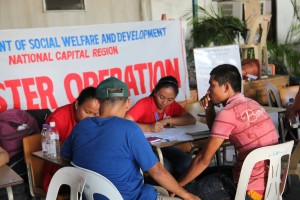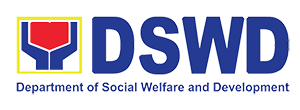
Pasay City – Staff from the Department of Social Welfare and Development-National Capital Region (DSWD-NCR) continue to provide assistance to the people fleeing the typhoon-hit Eastern Visayas and arriving at the Villamor Airbase via C130 since November 15, when the first batch of evacuees arrived.
As of 1:00 pm today, a total of 1,018 families or 3,463 individuals have arrived in city and have been given aid.
Upon arrival, social workers interview them to get their personal circumstances. They are then led to the volunteer-counselors and stress debriefers who conduct “emotional first aid.”
“Many of the survivors are still traumatized and they need to unload what they are feeling,” said DSWD-NCR Team Leader Farrah Cabrera who was stationed here over the weekend.
“We accomplish the intake sheet of each individual to determine what type of assistance we can offer them,” Cabrera added.
Those who have no relatives or friends in Metro Manila are taken to DSWD facilities such as the Jose Fabella Center (JFC), Reception and Study Center for Children (RSCC), and Nayon ng Kabataan (NK) where they can temporarily stay.
Some 419 evacuees were brought to these facilities but as of today, only six evacuees are still in RSCC, two in NK, and 106 in JFC as the rest have gone to their relatives already.
DSWD-accredited non-government organizations also accept evacuees.
On the other hand, individuals needing medical attention were immediately referred to the volunteer doctors and nurses of SM Foundation and service personnel of the Philippine Air Force. Twenty-two evacuees were referred to various government hospitals in Metro Manila.
“Libreng tawag” stations courtesy of telecommunications companies provide free calls to those who want to contact their families and relatives who will fetch them.
Lending a helping hand
The bayanihan spirit among Filipinos is once again demonstrated here as people from all walks of life volunteer as marshals to escort the arriving survivors and as counselors for the stress debriefing sessions.
Others assist in food distribution while vehicle owners ferry the survivors to their destinations through “Oplan Hatid.”
Upon disembarking, the survivors were immediately given hot meals and water, then led to a clothes corner where volunteers of Nanay Bayanihan sort new and used clothes to give to them.
Ted Sadile, volunteer of Oplan Hatid waited to ferry a sibling from Guiuan, Eastern Samar to their aunt’s place in Pasig City.
“I can accommodate three more going in the same route,” Sadile said.
Oplan Hatid volunteers ferry their passengers to various destinations in Metro Manila and even to nearby provinces in Southern Luzon.
According to DSWD-NCR, some 490 individuals were provided free transportation service by UNTV bus.
Tess Santillan, from San Pablo, Laguna is also a volunteer.
People line-up to hand her pieces of paper where they have written the names of their family members and relatives who will fetch them. Tess then reads the names using a microphone.
“It’s tiring,” she stated, “but every time I see a family reunited, all the tension goes away.”
Tess and two other women take turns making the announcements.
One of the organizers of the volunteer work remarked that they need more people especially during weekdays, and in the graveyard shifts.
“They constantly arrive and we have to be ready to lend them a hand,” she said # # #


